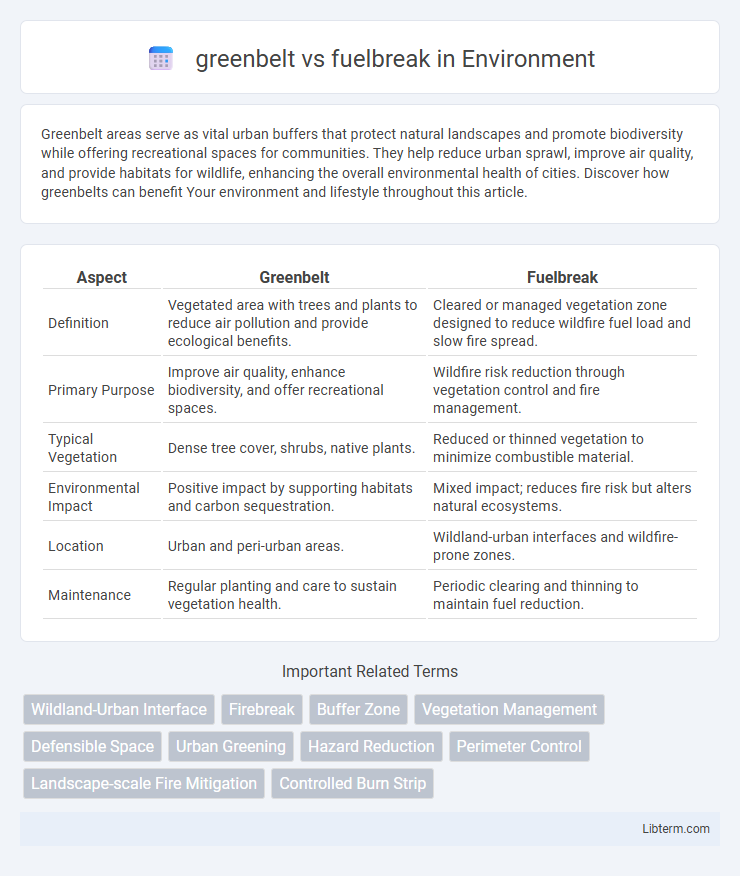Greenbelt areas serve as vital urban buffers that protect natural landscapes and promote biodiversity while offering recreational spaces for communities. They help reduce urban sprawl, improve air quality, and provide habitats for wildlife, enhancing the overall environmental health of cities. Discover how greenbelts can benefit Your environment and lifestyle throughout this article.
Table of Comparison
| Aspect | Greenbelt | Fuelbreak |
|---|---|---|
| Definition | Vegetated area with trees and plants to reduce air pollution and provide ecological benefits. | Cleared or managed vegetation zone designed to reduce wildfire fuel load and slow fire spread. |
| Primary Purpose | Improve air quality, enhance biodiversity, and offer recreational spaces. | Wildfire risk reduction through vegetation control and fire management. |
| Typical Vegetation | Dense tree cover, shrubs, native plants. | Reduced or thinned vegetation to minimize combustible material. |
| Environmental Impact | Positive impact by supporting habitats and carbon sequestration. | Mixed impact; reduces fire risk but alters natural ecosystems. |
| Location | Urban and peri-urban areas. | Wildland-urban interfaces and wildfire-prone zones. |
| Maintenance | Regular planting and care to sustain vegetation health. | Periodic clearing and thinning to maintain fuel reduction. |
Understanding Greenbelts: Definition and Purpose
Greenbelts are strategically planned strips of vegetation or open land designed to limit urban sprawl and preserve natural ecosystems by acting as buffer zones between developed and undeveloped areas. Fuelbreaks serve a different purpose, mainly focusing on wildfire management by creating reduced-fuel zones that slow or stop the spread of fires. Understanding greenbelts involves recognizing their role in sustainable land use, environmental protection, and maintaining biodiversity, contrasting with fuelbreaks' emphasis on fire prevention and control.
What Are Fuelbreaks? Key Functions Explained
Fuelbreaks are strategically cleared or thinned strips of vegetation designed to slow or stop the spread of wildfires by reducing available fuels. They create defensible zones for firefighters, enhancing safety and allowing for more effective fire suppression efforts. Commonly composed of low-flammability plants or bare ground, fuelbreaks function as barriers that interrupt fire continuity in forested or wildland-urban interface areas.
Greenbelt vs Fuelbreak: Core Differences
Greenbelt and fuelbreak both serve as wildfire mitigation strategies but differ fundamentally in design and purpose. Greenbelts are large, continuous areas of lush, often irrigated vegetation that act as natural fire barriers and enhance urban green space. Fuelbreaks consist of strategically thinned or cleared zones that reduce combustible material to slow fire spread and provide access for firefighting efforts.
Ecological Impact of Greenbelts and Fuelbreaks
Greenbelts preserve natural habitats and promote biodiversity by maintaining vegetation corridors, while fuelbreaks primarily reduce wildfire risk through thinning or removing flammable vegetation, often altering ecosystem structure. Ecologically, greenbelts support soil stability, water quality, and wildlife movement, whereas fuelbreaks can fragment habitats and disrupt ecological processes due to vegetation removal. The choice between greenbelts and fuelbreaks requires balancing fire management goals with conservation priorities to optimize environmental benefits.
Fire Prevention: Effectiveness of Greenbelts vs Fuelbreaks
Greenbelts act as natural fire barriers by maintaining dense, moist vegetation that slows fire spread and reduces intensity, enhancing fire prevention around urban areas. Fuelbreaks, created through strategic removal of flammable materials, effectively decrease available fuel load and disrupt fire continuity, making them essential for controlling wildfires in high-risk forests. Combining greenbelts and fuelbreaks optimizes landscape fire management by balancing ecological benefits with targeted fire suppression strategies.
Urban Planning Implications of Greenbelts and Fuelbreaks
Greenbelts serve as strategic urban planning tools that limit urban sprawl by preserving natural landscapes and promoting controlled development, enhancing ecological stability and recreational spaces. Fuelbreaks, designed primarily to reduce wildfire risk, influence land use planning by creating defensible zones that can alter development patterns and infrastructure placement in wildfire-prone urban fringes. Integrating greenbelts and fuelbreaks in urban design improves resilience against hazards while balancing growth control and environmental protection.
Maintenance and Management Challenges
Greenbelts require frequent and intensive maintenance to sustain vegetation density, prevent invasive species, and ensure ecological balance, which demands continuous monitoring and significant resource allocation. Fuelbreaks, designed primarily to reduce wildfire fuel loads, involve periodic clearing, pruning, and removal of combustible materials, often facing challenges with regrowth and erosion control. Both greenbelts and fuelbreaks require adaptive management strategies to address environmental changes, long-term sustainability, and potential fire risk variability.
Legal and Policy Considerations
Greenbelt and fuelbreak implementations are governed by distinct legal frameworks that dictate land use, environmental protection, and property rights, influencing their design and maintenance. Greenbelts are often subject to strict zoning laws and conservation policies aimed at limiting urban sprawl and preserving natural habitats, while fuelbreak regulations prioritize wildfire risk reduction, frequently permitting more intrusive vegetation management. Understanding these policy differences is critical for land managers and policymakers to ensure compliance and effectively balance ecological benefits with fire prevention objectives.
Community and Environmental Benefits Compared
Greenbelts provide extensive community benefits by preserving natural landscapes, promoting biodiversity, and offering recreational spaces that enhance residents' well-being. Fuelbreaks primarily focus on reducing wildfire risks by managing vegetation to slow fire spread, which indirectly supports community safety and property protection. Both strategies contribute to environmental sustainability, but greenbelts emphasize ecosystem preservation while fuelbreaks prioritize hazard mitigation.
Choosing the Right Strategy: Greenbelt or Fuelbreak?
Choosing between a greenbelt and a fuelbreak depends on specific wildfire risk factors and landscape characteristics. Greenbelts prioritize maintaining healthy vegetation to act as natural fire buffers, while fuelbreaks involve actively reducing flammable materials to slow fire spread. Effective wildfire management requires assessing vegetation types, topography, and fire behavior to determine the optimal strategy for protection.
greenbelt Infographic

 libterm.com
libterm.com